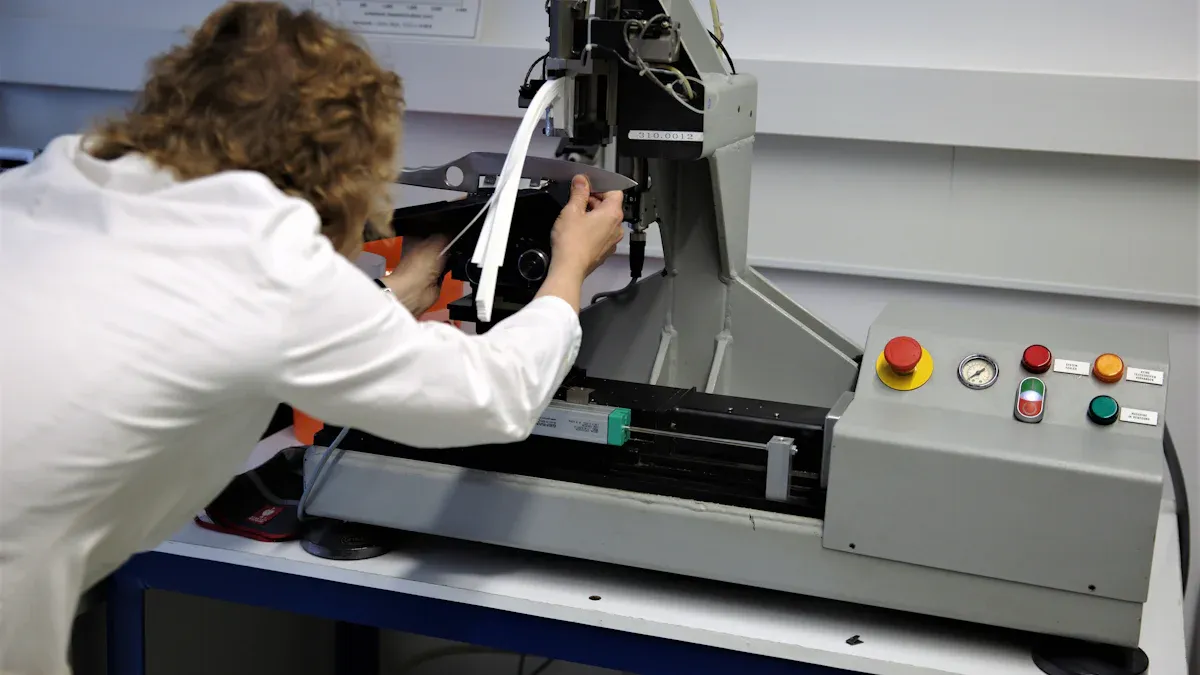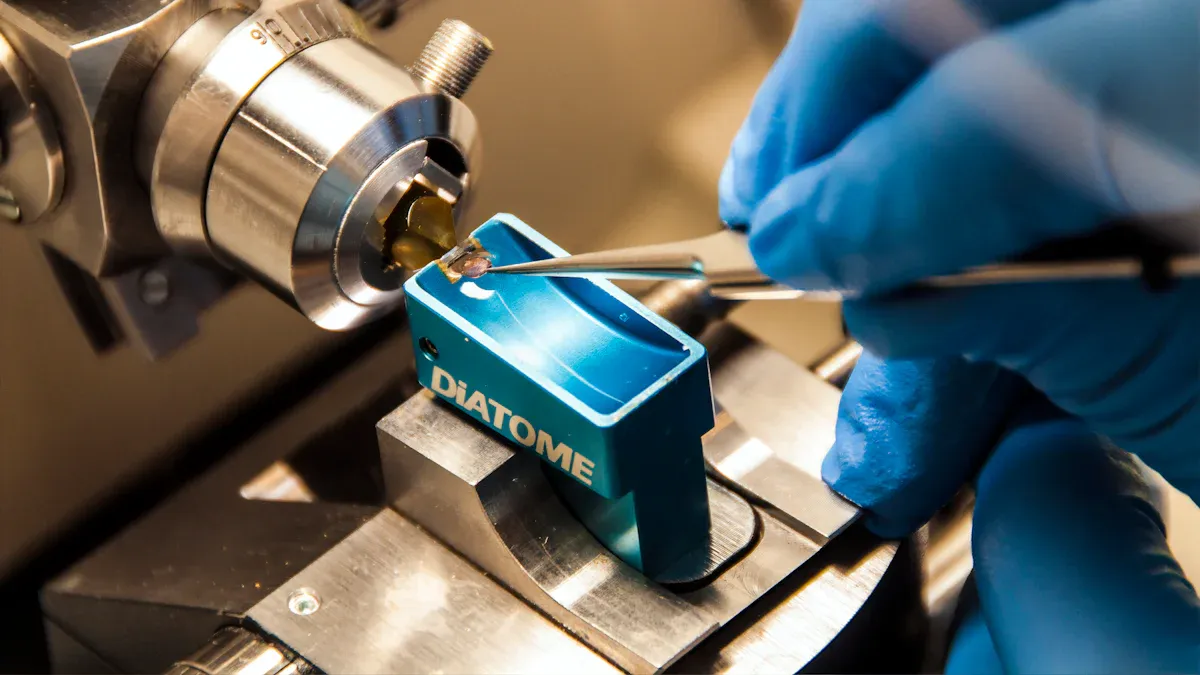Understanding Non-Destructive Testing Methods and Their Applications

Non-destructive testing evaluates the integrity and quality of materials or components without causing damage. This method plays a vital role in industries by enhancing safety, reliability, and cost-effectiveness. Recent trends highlight its growing importance.
The global non-destructive testing market is projected to grow from USD 2.1 billion in 2023 to USD 3.7 billion by 2032, with a CAGR of 6.5%.
Advanced NDT technologies, such as ultrasonic phased array, have improved defect detection, preventing material failures in critical sectors like aerospace.
An NDT technician ensures compliance with safety standards, protecting both equipment and human lives.
What is Non-Destructive Testing?
Definition and Purpose
Non-destructive testing (NDT) refers to a group of techniques used to evaluate the properties of materials, components, or systems without causing any damage. These methods allow for the detection of flaws, measurement of material properties, and assessment of structural integrity. NDT plays a critical role in industries where safety and reliability are paramount.
The primary purpose of non-destructive testing is to ensure that materials meet quality standards while maintaining their usability. By employing techniques such as ultrasonic and electromagnetic testing, industries can assess the physical properties of structures without compromising their integrity. This approach is essential for quality control, as it enables the evaluation of larger areas and provides insights into material variability.
NDT methods are categorised into various techniques, each tailored to specific applications. For example, ultrasonic testing is widely used in aerospace and automotive sectors due to its high sensitivity to small flaws. Similarly, X-ray radiography offers detailed imaging for medical and material science applications. The table below highlights some common NDT methods, their applications, and their advantages and disadvantages:
NDT Method | Applications in Industries | Advantages | Disadvantages |
|---|---|---|---|
Ultrasonic Testing | Aerospace, automotive, manufacturing | High sensitivity to small flaws | Limited to certain materials |
X-ray Radiography | Medical imaging, material science, aerospace | Non-invasive, detailed imaging | Radiation exposure |
Infrared Thermography | Electrical inspections, building diagnostics | Quick and easy to use | Limited depth of penetration |
Neutron Radiography | Nuclear industry, aerospace, and materials research | Can penetrate dense materials | Limited availability of facilities |
Acoustic Emission | Structural health monitoring, pressure vessels | Real-time monitoring | Requires interpretation of signals |
Digital Imaging | Quality control in manufacturing, biomedical applications | High resolution | Equipment cost |
Shearography | Aerospace, automotive, and civil engineering | Sensitive to surface defects | Requires skilled operators |
Importance in Quality Control and Safety
Non-destructive testing is indispensable for quality control and safety in various industries. It ensures that materials and components meet stringent standards before deployment. This is particularly important in sectors such as aerospace, manufacturing, and power generation, where failures can have catastrophic consequences.
The manufacturing sector accounted for over 22% of the NDT market share in 2022, driven by increased production activities. In power generation, the adoption of NDT techniques is growing at a compound annual growth rate (CAGR) of 8.6%. These figures highlight the critical role of NDT in maintaining operational efficiency and safety.
NDT also contributes significantly to safety protocols. For instance, rigorous testing procedures in industrial applications ensure vessel integrity, while quality assurance metrics in strength-critical projects enhance safety outcomes. The table below illustrates the impact of NDT on safety protocols:
Case Study Description | Impact on Safety Protocols |
|---|---|
NDT in complex industrial applications | Ensured vessel integrity and safety through rigorous testing procedures. |
NDT in critical strength projects | Enhanced quality assurance metrics, leading to improved safety outcomes. |
NDT in complicated fabrication scenarios | Provided valuable insights that refined techniques and deepened understanding of pressure vessel integrity. |
An NDT technician plays a vital role in implementing these techniques effectively. By adhering to defined procedures, they ensure compliance with safety standards and contribute to the prevention of material failures. This not only protects equipment but also safeguards human lives.
Methods of Non-Destructive Testing

Visual Testing (VT)
Visual testing is one of the simplest and most widely used non-destructive testing methods. It involves examining the surface of a material or component for visible defects such as cracks, corrosion, or deformation. An NDT technician relies on their expertise and visual acuity to identify flaws, making this method highly dependent on human skill.
Visual inspection offers immediate results and requires minimal equipment, making it cost-effective. However, it is limited to surface defects and cannot detect internal flaws. The effectiveness of this method often varies based on the inspector's experience, introducing subjectivity into the process.
Tip: Combining visual testing with other NDT techniques enhances defect detection capabilities, especially for internal flaws.
Aspect | Other NDT Methods | |
|---|---|---|
Advantages | Simple, cost-effective, immediate results | Varies by method |
Limitations | Limited to surface defects, subjective | Can detect internal defects, less subjective |
Equipment Requirement | Minimal, relies on human eye | Often requires specialised equipment |
Magnetic Particle Testing (MT)
Magnetic particle testing is a defect detection technique used to identify surface and subsurface flaws in ferromagnetic materials. This method involves applying a magnetic field to the material and introducing magnetic particles, which accumulate around defects, making them visible.
MT is highly effective for detecting cracks, seams, and other discontinuities in metals. It is widely used in industries such as manufacturing and aerospace, where material integrity is critical. However, this method is limited to ferromagnetic materials and requires specialised equipment.
Technical Specifications and Performance Metrics | |
|---|---|
Magnetic Particle Testing | Utilises magnetic fields to identify surface and subsurface defects in ferromagnetic materials. |
Liquid Penetrant Testing (PT)
Liquid penetrant testing, also known as dye penetrant testing, is a widely used NDT technique for detecting surface defects in non-porous materials. This method involves applying a liquid dye to the surface, allowing it to seep into cracks or voids. After a specified dwell time, the excess dye is removed, and a developer is applied to make the defects visible.
PT is highly effective for identifying surface flaws such as cracks, pinholes, and porosity. It is commonly used in industries like oil and gas, automotive, and construction. This method is versatile and can be applied to various materials, but it is limited to surface defects and requires careful handling of chemicals.
Note: Liquid penetrant testing is ideal for detecting surface flaws in non-ferromagnetic materials, complementing other NDT methods like MT.
NDT Method | Technical Specifications and Performance Metrics |
|---|---|
Radiographic Testing | Uses X-rays or gamma rays to create images of internal structures for defect analysis. |
Ultrasonic Testing | Employs high-frequency sound waves to detect defects, with echoes converted into images for analysis. |
Magnetic Particle Testing | Utilises magnetic fields to identify surface and subsurface defects in ferromagnetic materials. |
Radiographic Testing (RT)
Radiographic testing uses X-rays or gamma rays to inspect the internal structure of materials. This method creates images that reveal defects such as cracks, voids, or inclusions. It is widely employed in industries like aerospace, construction, and manufacturing, where internal flaws can compromise safety and performance.
The process begins with the placement of the material between a radiation source and a detector. The radiation passes through the material, and variations in density create an image on the detector. Areas with defects appear darker or lighter, depending on the type of flaw. This visual representation allows technicians to identify and evaluate imperfections without damaging the material.
Radiographic testing offers several advantages. It provides detailed images of internal structures, enabling precise defect analysis. It is non-invasive and suitable for a wide range of materials, including metals, composites, and ceramics. However, it requires specialised equipment and trained personnel. Exposure to radiation also necessitates strict safety protocols.
Tip: Regular calibration of radiographic equipment ensures accurate results and enhances defect detection capabilities.
Aspect | Details |
|---|---|
Applications | Aerospace, construction, manufacturing |
Advantages | Detailed imaging, non-invasive, versatile |
Limitations | Requires specialised equipment, radiation safety measures |
Ultrasonic Testing (UT)
Ultrasonic testing employs high-frequency sound waves to detect defects within materials. This method is highly effective for identifying flaws such as cracks, voids, and delaminations. It is commonly used in industries like oil and gas, automotive, and power generation, where material integrity is critical.
The technique involves transmitting sound waves into the material using a transducer. These waves travel through the material and reflect back when they encounter a defect. The reflected waves are captured and analysed to determine the size, location, and nature of the flaw. Ultrasonic testing provides real-time results, making it a valuable tool for quality control.
Ultrasonic testing offers several benefits. It is highly sensitive to small defects and can penetrate thick materials. It is also portable and relatively quick to perform. However, it requires skilled operators and may not be suitable for materials with irregular surfaces or complex geometries.
Note: Combining ultrasonic testing with other non-destructive testing methods enhances defect detection and provides a comprehensive assessment of material integrity.
Aspect | Details |
|---|---|
Applications | Oil and gas, automotive, power generation |
Advantages | High sensitivity, real-time results, portable |
Limitations | Requires skilled operators, limited for irregular surfaces |
Advantages and Limitations of Non-Destructive Testing
Benefits of NDT Methods
Non-destructive testing offers numerous advantages that make it indispensable across industries. One of its primary benefits is its ability to evaluate materials and components without causing damage. This ensures that assets remain operational during testing, reducing downtime and maintaining productivity. For instance, an NDT technician can inspect weld integrity in pipelines or structures without interrupting their functionality.
NDT methods also contribute significantly to cost efficiency. Preventative maintenance based on NDT results saves money over time by identifying potential issues early. Timely repairs or replacements prevent expensive failures, ensuring long-term operational reliability. Additionally, these methods do not produce waste, aligning with sustainable practices and further reducing costs.
Another key advantage is the versatility of NDT techniques. They can be applied to a wide range of materials, including metals, composites, and ceramics. This flexibility makes them suitable for diverse industries such as aerospace, oil and gas, and construction. Moreover, advanced technologies like ultrasonic and radiographic testing provide precise defect detection, enhancing safety and quality assurance.
Tip: Regular training for NDT technicians ensures accurate results and maximises the benefits of these methods.
Challenges and Limitations
Despite its advantages, non-destructive testing has certain limitations. Many NDT methods require specialised equipment and skilled operators, which can increase initial costs. For example, radiographic testing involves the use of X-rays or gamma rays, necessitating strict safety protocols and trained personnel.
Some techniques are material-specific, limiting their applicability. Magnetic particle testing, for instance, works only on ferromagnetic materials, while liquid penetrant testing is restricted to non-porous surfaces. Additionally, certain methods, such as ultrasonic testing, may struggle with irregular surfaces or complex geometries, reducing their effectiveness in specific scenarios.
Another challenge lies in the interpretation of results. Accurate analysis often depends on the expertise of the NDT technician. Misinterpretation can lead to incorrect assessments, potentially compromising safety and reliability.
Note: Investing in advanced training and equipment can help overcome many of these challenges, ensuring the effective implementation of NDT methods.
Applications of Non-Destructive Testing

Aerospace Industry
Non-destructive testing plays a critical role in the aerospace industry, where safety and reliability are paramount. It helps detect flaws and irregularities that could lead to catastrophic failures. Techniques such as ultrasonic testing and radiographic testing are widely used to inspect aircraft components, ensuring their structural integrity. These methods preserve the usability of parts, allowing for continued operation after testing.
NDT also supports preventive maintenance by identifying potential issues before they escalate. This extends the lifespan of components and reduces downtime. For example, ultrasonic testing can detect cracks in turbine blades, preventing costly repairs or replacements.
Key benefits of NDT in aerospace:
Detects flaws that compromise safety and reliability.
Preserves component integrity post-testing.
Enables early detection of issues, reducing maintenance costs.
Note: The transition from traditional methods to digital technologies, such as digital radiography, has improved inspection speed and reduced radiation exposure.
Manufacturing and Construction
Non-destructive testing enhances quality control in manufacturing and construction. It ensures that materials and structures meet safety standards before deployment. Techniques like ultrasonic pulse velocity and Schmidt rebound hammer testing are commonly used to assess concrete strength. These methods provide reliable results, reducing the risk of structural failures.
Empirical studies highlight the effectiveness of NDT in predicting material strength. For instance:
Metric | Value |
|---|---|
R-squared value | 0.8973 |
Difference in core vs. cylinder strength | 7% to 19.5% |
Combined NDT methods | More reliable results closer to true values |
NDT also improves efficiency by reducing the need for destructive testing. This minimises waste and lowers costs, making it a sustainable choice for the industry.
Oil and Gas Sector
The oil and gas sector relies heavily on non-destructive testing to ensure the safety and reliability of critical assets. NDT techniques, such as ultrasonic testing and radiography, detect material defects without causing damage. This allows for frequent inspections, ensuring equipment integrity and preventing failures.
NDT creates safer operating environments by identifying issues before they lead to pipeline spills or other hazards. It also improves efficiency by enabling in-field testing, reducing labour demands and downtime.
Key advantages of NDT in oil and gas:
Detects defects without damaging equipment.
Prevents pipeline spills, enhancing safety.
Reduces labour and downtime, improving operational efficiency.
Tip: The growing reliance on NDT in this sector reflects its importance in maintaining safety standards and reducing costs.
Automotive Industry
Non-destructive testing plays a vital role in the automotive industry by ensuring the safety and reliability of vehicles. Manufacturers use NDT techniques to inspect components for defects without causing damage. This approach helps maintain product quality while reducing waste and production costs.
Several NDT methods are commonly employed in the automotive sector. X-ray imaging is used to examine internal structures, such as engine blocks and transmission systems, for cracks or voids. Ultrasonic testing detects flaws in welds and other critical joints, ensuring structural integrity. Infrared thermography identifies temperature variations that may indicate issues like overheating or material degradation. These techniques enhance the reliability of vehicles and improve safety for end-users.
The benefits of non-destructive testing in the automotive industry are well-documented. Studies highlight its effectiveness in quality control, where it ensures that components meet stringent safety standards. NDT also supports the development of lightweight materials, such as composites, which are increasingly used to improve fuel efficiency. By identifying defects early, manufacturers can prevent costly recalls and extend the lifespan of vehicle components.
Despite its advantages, NDT in the automotive sector faces challenges. Some methods require specialised equipment and skilled operators, which can increase costs. Additionally, certain techniques may struggle with complex geometries or materials, limiting their applicability. However, ongoing advancements in NDT technologies continue to address these limitations, making them more accessible and efficient.
Tip: Combining multiple NDT methods often provides a more comprehensive assessment of automotive components, enhancing defect detection and overall reliability.
FAQ
What is the main purpose of non-destructive testing (NDT)?
NDT evaluates materials and components for defects without causing damage. It ensures safety, reliability, and compliance with quality standards across industries.
Which industries benefit the most from NDT methods?
Industries such as aerospace, oil and gas, automotive, and construction rely heavily on NDT. These sectors use it to maintain safety, improve efficiency, and reduce costs.
Are NDT methods suitable for all materials?
Not all materials are compatible with every NDT method. For example, magnetic particle testing works only on ferromagnetic materials, while liquid penetrant testing requires non-porous surfaces.
How does NDT contribute to cost savings?
NDT prevents failures by detecting defects early. This reduces downtime, minimises waste, and avoids expensive repairs or replacements.
Do NDT methods require specialised training?
Yes, many NDT techniques need skilled operators. Proper training ensures accurate defect detection and compliance with safety protocols.
See Also
Guidelines for Choosing Measurement Instruments in Quality Assurance
Understanding Functional Testing Within CNC and Die Casting
A Comprehensive Guide to Various Heat Treatment Techniques
An Overview of Powder Coating Techniques and Applications
Boosting Engineering Efficiency Through Quick Response Strategies
About Hunan Puka
Established in 2016 and based in Hunan, China, with a liaison point in Berlin, we are a Tier 2 supplier for the automobile industry. We specialize in the production of customized aluminum die-casting parts designed for machines with a closing force ranging from 280 to 1250 tons, with subsequent manufacturing process CNC machining and surface treatment. Our commitment to quality is reflected in our accredited quality management system, certified by ISO9001:2015 and IATF16949:2016 standards.


